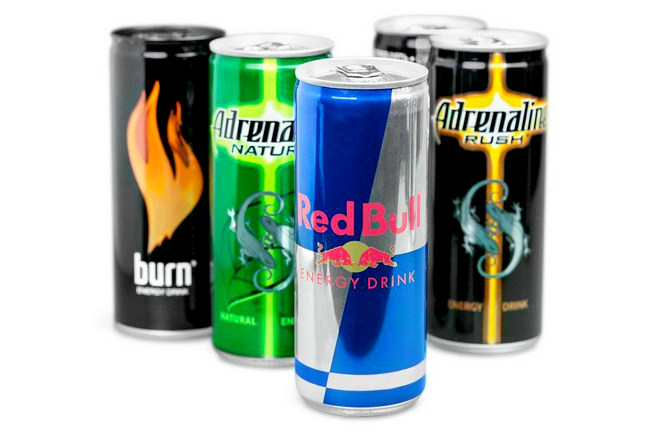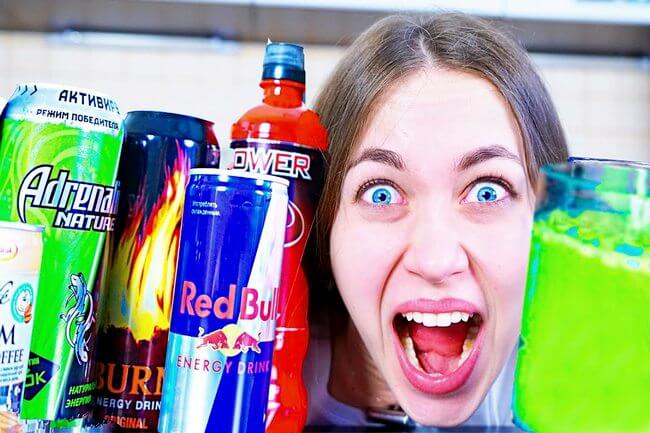The beverages of the third millennium—that is what energy drinks are called, and they are indeed very popular. Students who have to sit up all night studying for projects; young people hanging out at clubs; truck drivers, security guards, janitors, and other people who work around the clock; those who have to go to the gym after a hard day’s work—this is far from an exhaustive list of those who drink them.
Despite the fact that the media often warns about the harmful effects of energy drinks on the body, they still remain sales leaders. So do they do more good or harm?
General information

Energy drinks are beverages with a pronounced tonic, anti-sedative effect due to the presence of natural psychostimulants in their composition. They are recommended for use to quickly restore strength and get rid of fatigue and drowsiness. They are mainly taken by those who need to stay awake or double their energy for several hours.
Many people believe that this is a 21st century discovery, but that is not the case. Their counterparts can be found in the works of ancient herbalists. In particular, one of the books by the famous German abbess Hildegard von Bingen (12th century) describes a recipe for an elixir that gives vitality.
They appeared in the form that we know them now a century ago. In 1927, Lucozade was created in Great Britain for the accelerated recovery of patients, with a composition typical of modern energy drinks: carbon dioxide, glucose syrup, citric and lactic acids, caffeine, sodium benzoate and bisulfate, and vitamin B9.
On its basis, a new drink, Lipovitan, was created in Japan in 1962, which began to be sold not as a drug for accelerated recovery, but as a stimulating drink that prevents sleep for several hours and provides a surge of strength and vigor. Since then, the production of energy drinks in the East has been put on stream.
In Europe, this was initiated by the Austrian entrepreneur Dietrich Mateschitz, who borrowed the recipe while vacationing in Hong Kong. Having embellished it with modern, more advanced components, he created a completely new product, Red Bull, which eventually made him one of the richest people on the planet. The brand has a scandalous reputation, but it is still incredibly popular all over the world.
In 1985, energy drinks took over America thanks to Jolt Cola, which was recommended to students and people in professions that require prolonged mental and physical exertion. In 1995, it was replaced by Josta from PepsiCo, on the basis of which Adrenaline Rush began to be produced since 1999.
In New Zealand and Australia, drinks from Frucor Beverages are the sales leaders.
Sales volume today is over $50 billion.
Many people are interested in the question of at what age energy drinks are sold. If they do not contain alcohol, they can be freely sold to people of any age in the Russian Federation, including children and adolescents. This is not prohibited by law. The exception is the Moscow region, where it is forbidden to sell such drinks to minors as of 01.05.2015.
Effect on the body
Since the mass production of energy drinks was established, there has been ongoing discussion about what effect they have on human health. To figure out whether they do more good or harm, you need to know which systems and organs they affect and how.
Properties:
- tonic—they raise the vitality, providing a state of prolonged excitation of the nervous system and muscle tissue without fatigue;
- stimulate the central nervous system—they cause an increase in its activity and accelerate its functioning;
- provide an anti-sedative effect—they invigorate, relieve drowsiness and lethargy, and prevent sleep.

Thanks to these properties, after drinking the beverage, the following occurs within 2-4 hours (the duration of action depends on the individual characteristics of the body):
- mood rises sharply up to a euphoric state;
- there is a surge of strength, vigor, and energy;
- there is no desire to sleep;
- work capacity increases;
- strength and endurance indicators improve;
- thought activity is stimulated;
- the desire for physical activity is enhanced.
A person experiences all of this within 5-10 minutes after drinking the beverage. But there is also another side to this coin that is not so noticeable.
It seems to everyone that energy drinks are a source of energy in and of themselves. This is not the case. The active substances that make up their composition are stimulants that act according to a simple scheme: they are quickly absorbed into the blood, excite the nervous system, forcing the body to expend its own energy in a doubled dose and then deliver it to the cells. That is, they do not supply the body with energy, but take it away from the body itself in large quantities.
An example for clarity and comparison. A loader has to unload 4 cars during an 8-hour working day. He can do this by distributing the load evenly—1 car in 2 hours. At the same time, he will take breaks for rest and as a result will only feel slight fatigue at the end of the working day. But he can do it differently: he can unload all 4 cars in 2 hours, working quickly, without recovering his strength. As a result, he will exhaust all the reserves of his body and will feel bad by the end of the second hour.
The same thing happens with the body, which normally distributes the available energy evenly. Energy drinks force it to expend all of it in a short period of time. It is not difficult to guess what will happen when the effect ends: exhaustion, loss of strength, poor health—and this is not an exhaustive list of the sensations that will have to be experienced after the euphoria.
So the effect of energy drinks on the human body is a vivid example of a double-edged sword. On the one hand, there is a surge of strength and an incredible rush of vigor when you feel like moving mountains. But this is followed by complete exhaustion of the body and nervous system after a few hours.
Composition
The effect of energy drinks on the body is determined by the active substances that make up their composition. The base is the same for almost all brands, with minor deviations.
Main active ingredients:
- glucose—the main “energy extractor” from the body;
- taurine—an amino acid that accelerates energy processes in the body;
- caffeine—an alkaloid psychostimulant that tones the central nervous system and cardiac activity, speeds up the pulse, causes blood vessels to dilate, increases intellectual and physical performance, and eliminates drowsiness;
- guarana—a vine whose extract contains a large amount of caffeine, lifts the spirits, and invigorates;
- ginseng—a natural psychostimulant;
- nicotinic acid (vitamin B3) stabilizes the functioning of the nervous system;
- pantothenic acid (B5) participates in the restoration of nerve tissues;
- pyridoxine (B6) has a regulatory effect on the nervous system;
- folic acid (B9) increases the production of serotonin and norepinephrine in the body, which lift the mood;
- ascorbic acid (C) delivers glucose to the address and participates in the production of serotonin.
This is not counting the preservatives, dyes, and carbonic acid that make them carbonated. Caffeine and glucose are essential ingredients. Taurine is found in 75% of the drinks.
At first glance, the composition may seem balanced: some substances tone the nervous system, while others soothe and stabilize it. In fact, there are several times more of the former than the latter. Manufacturers use only 1-2 vitamins and in minimal quantities.
Harm
Why do the media constantly talk about the fact that energy drinks are dangerous? At one time (2009-2010), Red Bull was banned in several countries due to the fact that elements of cocaine were allegedly found in it. The examination subsequently refuted this fact, but a wave of indignation and protests was launched.
